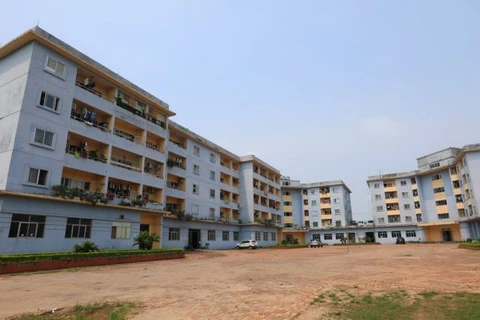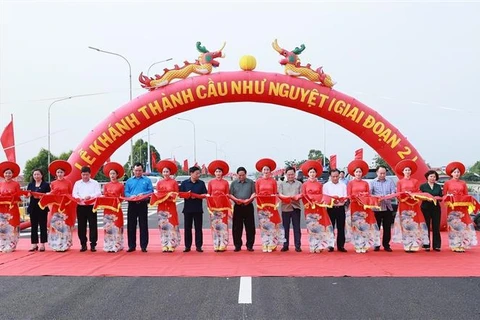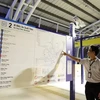Hanoi (VNS/VNA) - A large-scale project to build at least one million social housing apartments for low-income people and industrial park workers before 2030 is underway. Current demand outstrips supply, causing some to press for faster action.
A survey conducted by the Vietnam General Confederation of Labour reveals that 60% of workers currently rent homes outside of industrial zones, with their monthly rental costs accounting for 30% of their total income.
Nguyen Hong Van, Deputy Director of the Valuation and Financial Advisory Department at Savills Vietnam, highlighted the limited supply of worker housing.
There are approximately 4.5 million workers in industrial zones across Vietnam. Half of them require accommodation, with the demand for housing amounting to 12.5 million square metres of floor space.
Despite the considerable demand, the current supply only satisfies around 30% of the actual need. Consequently, people have resorted to hostels near industrial parks to live. Many of these motels are old, deteriorating, and overcrowded, posing significant health and safety risks to tenants.
Hai Phong city is known as the locomotive of industrial development in the North. The city is home to 14 operational industrial parks, 26 industrial clusters, and over 200,000 employees, including around 50,000 migrant workers. The housing options in the area are insufficient to meet the needs of this workforce.
This locality has devised plans to establish 15 additional industrial zones on 6,000 hectares of land. These zones are projected to require a workforce of up to 300,000 people, resulting in a substantial demand for worker housing, estimated to be around 1.5 million square metres of floor space.
In Hai Phong city, the primary form of worker housing is rented dormitories. Van said a survey revealed that workers' housing in Thuy Nguyen district, which encompasses the VSIP Hai Phong Industrial Park and Nam Cau Kien Industrial Park, has an average gross rent ranging from 3.2-4.2 USD per square metre per month.
Two notable worker housing projects currently in operation include 278 units constructed by LG Display and 330 units developed by Golden Peak Company in Duong Kinh district. The occupancy rate for worker housing in this area consistently remains high, hovering around 95%.
Tran Tuan Anh, deputy head of the Management Board of Hanoi Industrial Parks and Export Processing Zones, said that existing industrial parks, particularly the older ones, were not planned to accommodate worker housing. The planning, development, and management of worker housing projects has faced numerous obstacles as they primarily involve technical infrastructure works.
Despite the growing demand for worker housing, limited and inaccessible capital sources pose significant challenges to the development programme. The current preferential policies related to capital are insufficient to incentivise businesses, organisations, and individuals to invest in worker housing construction.
Furthermore, the project's payback period, ranging from 20 to 30 years, exacerbates the difficulties in calling private investment in housing development.
Van from Savills Vietnam noted that there was previously no legal framework or clear definition for worker housing. However, the recent passing of Decree 33, which focuses on promoting safe, healthy, and sustainable development in the real estate market, has brought about crucial commitments concerning public and social housing. The development of these housing types is now incorporated into the general planning of localities and the nation as a whole.
Additionally, the State has introduced various policies to encourage investment in development and support packages for workers to access housing products. Specific regulations have been implemented for certain industrial zones, mandating that at least 2% of the total land area be allocated for worker housing. Proposals have been made to exempt land use tax for the development of worker housing.
Furthermore, several financial mechanisms are being proposed to assist developers, such as the exemption or reduction of value-added tax and corporate income tax. Construction costs can also be deducted when calculating corporate income tax. Developers can access concessional loans from the Bank for Social Policies and other credit institutions operating in Vietnam.
Workers themselves can benefit from the Government's VNĐ15 trillion credit support package. According to Resolution 33, employees seeking to purchase or rent affordable housing can receive support in the form of a loan with an interest rate of 2% per year for two years, spanning from 2022 to 2023.
Worker housing and social housing differ primarily in terms of location and legality. Social housing can be developed in various locations, whereas worker housing is concentrated in and around industrial zones.
Buyers of social housing receive long-term or 50-year ownership certificates (red books) and can transfer the property to eligible individuals only after at least five years from the termination date of the house purchase or lease contract.
Worker housing is predominantly designed as rental apartments and is developed by either State-owned or private enterprises. Three entities are authorised to provide worker housing, including industrial park infrastructure development enterprises, manufacturing enterprises within industrial parks, and real estate businesses.
Currently, in the northern provinces, manufacturing enterprises in industrial zones have provided 70 % of worker apartments.
Worker housing typically comprises low-rise buildings with a maximum height of five floors and lacks elevators. Ground-level parking areas, community living areas, canteens, mini supermarkets, green spaces, and playgrounds are common supporting facilities.
The rooms in worker housing are divided into two types: single rooms and household rooms. Single rooms have an average size of about 30-35 square metres and can accommodate up to six occupants. Household rooms have an average area of 25 square metres and can accommodate a family of four people.
Despite the forthcoming deployment of additional housing projects for workers, the demand for this segment remains significantly high and unmet. Savills' price index for the first quarter of 2023 reveals that the manufacturing sector witnessed a notable increase of 482,000 workers compared to the same period last year, indicating a substantial demand for labour from early in the year.
Given the persistent demand in the market, private enterprises stand to benefit from investing in the worker housing segment. The ongoing development of the industrial sector, stable inflows of foreign direct investment (FDI), a productive workforce, and supportive investment policies create favourable conditions. Consequently, worker housing can emerge as an attractive niche for development in the near future, Van said./.
VNA
























